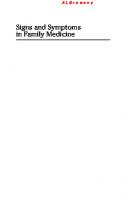Medically Unexplained Symptoms: A Brain-Centered Approach 3030591808, 9783030591809
Despite the rapid advances in medical science, the majority of people who visit a doctor have medically unexplained symp
176 10 3MB
English Pages 204 [216] Year 2021
Table of contents :
Foreword
Preface
References
Contents
1: Overview of Medically Unexplained Symptoms
Pain and Fibromyalgia
Brain Flaws
Fear
Anxiety
Stress
Chronic Fatigue Syndrome
Diagnostic Uncertainty
In Brief
References
2: Early Ideas on Hysteria
Hysteria and Female Sexuality
Bizarre Behaviors
Hysteria and the Occult
Nerves
Hysteria, a Nervous Disorder
Early Treatments of Hysteria
Spinal Irritation and the Spinal Reflex Theory
The Attack on the Female Genitalia
Hysteria and Fasting Girls
In Brief
References
3: The Golden Age of Hysteria
Briquet’s Syndrome
Charcot and His Hysterical Circus
Hysteria and Hypnosis
Borderlands of Hypnosis
Nature or Nurture
Ideas About Hysteria Evolve
Neurasthenia and Neurosis
Americanitis
Silas Weir Mitchell and the Civil War
The Rest Cure
Silas Weir Mitchell, the Enigma
Nerve Doctors
Evolution and the Brain
In Brief
References
4: Psychosomatic Illness in the Twentieth Century
Freud, the Early Years
Breuer’s Famous Patient, Bertha Pappenheim
Freud and Breuer’s Book on Hysteria
Suppressed Memories and Childhood Sexuality
Freud’s Model of the Mind
Overall Impact of Psychoanalysis
Physicians, Patients and Psychosomatic Symptoms
Common Sense Psychotherapy
Alternate Medical Treatments and Suggestibility
War and Psychogenic Illness
PTSD, the Prototypical Delayed Stress Disorder
Relationship Between PTSD and Mild Traumatic Brain Injury (MTBI)
Psychosomatic Medicine
In Brief
References
5: Biological Mechanisms of Psychosomatic Symptoms
The Biological Link Between Stress and Illness
The Hypothalamic-Sympathetic-Adrenal Axis
The Hypothalamic-Pituitary-Adrenal Axis
Stress and Neuroplasticity
Hebb’s Synapse
Molecular Mechanisms of Brain Plasticity
Stress and the Limbic System
Nerve Growth Factors and Stress
Proinflammatory Cytokines and Stress
The Amygdala-Prefrontal Cortex Connection
Central Sensitization, a Model of Neuroplasticity
The Descending Pain Modulatory System (DPMS)
Stress and Brain Neurotransmitters
Glutamate
Gamma Aminobutyric Acid (GABA)
Noradrenaline
Serotonin
Dopamine
Cannabinoids
Stress and Human Behavior
Operant Conditioning and Behavioral Therapy
In Brief
References
6: Psychosocial Mechanisms of Psychosomatic Symptoms
How Can Beliefs and Expectations Change Brain Function?
Doctor-Patient Relationship and Psychosomatic Symptoms
The Power of the Placebo
Placebo’s Evil Twin, Nocebo
Statins and Muscle Pain and Weakness
Glutens and Celiac Disease
Expectations and Beliefs
Hyperventilation Syndrome
Idiopathic Environmental Intolerance and the Nocebo Effect
The Belgium Coca-Cola Fiasco
Electromagnetic Hypersensitivity
Infrasound Sensitivity
Sick Building Syndrome
Overview of Idiopathic Environmental Intolerance Mechanisms
In Brief
References
7: Low Back Pain, Abdominal Pain and Headache
Overview of Common Pain Syndromes
Low Back Pain
Historical Perspective
Current Approach to Chronic Low Back Pain
Physical Activity and Expectation
Depression and Fear Avoidance
Abdominal Pain
Autonomic Nervous System and the Gut
Irritable Bowel Syndrome (IBS)
Peptic Ulcer Disease
Primary Headache Disorders
Migraine as a Model for Psychophysiological Illnesses
Historical Perspective
Migraine Auras
Early Ideas on the Cause of Migraine
Mechanism of the Migraine Aura
Genetic Susceptibility to Migraine
In Brief
References
8: Fibromyalgia and Chronic Fatigue Syndrome
Pain but Much More
Fibromyalgia
Tender Points
Central Sensitization to Pain
Repetitive Strain Injury (RSI)
Chronic Fatigue Syndrome
Epidemic and Sporadic Neuromyasthenia
Epstein-Barr Virus (EBV)
Chronic Fatigue Immune Dysfunction Syndrome (CFIDS)
Myalgic Encephalomyelitis (ME)
Mass Psychogenic Illness (Mass Hysteria)
Overlap with Depression and Other Psychogenic Illnesses
Genetics of Fibromyalgia and Chronic Fatigue Syndrome
In Brief
References
9: Chronic Dizziness
Anxiety and Dizziness
Near-Faint Dizziness and Fainting
Postural Orthostatic Tachycardia Syndrome (POTS)
Dizziness and Mass Psychogenic Illness
Persistent Postural Perceptual Dizziness (PPPD)
Migrainous Dizziness
Post-Concussion Dizziness
Dizziness and Fear of Falling in Older People
Sea Legs and Mal de Debarquement Syndrome
Height Vertigo and Acrophobia
In Brief
References
10: Treatment of Psychosomatic Symptoms
Lifestyle Changes
Exercise and the Brain
Sleep and Eating Habits
Mindfulness
Cognitive Behavioral Therapy
Internet-Directed Therapy
Drug Treatments
Drugs that Increase Brain Monoamines (Antidepressants)
Drugs that Decrease Excitatory (Glutamate) Transmission
Antiepileptic Drugs
Anxiolytic Drugs
Drugs that Enhance Neuroplasticity and Neurogenesis
Ketamine, The New “Wonder Drug”
Drugs that Affect Endocannibinoid Neurotransmission
Extracranial Brain Stimulation
Electroconvulsive Therapy (ECT)
Transcranial Direct Current Stimulation (tDCS)
Transcranial Magnetic Stimulation (TMS)
Deep Brain Stimulation
DBS for PTSD
In Brief
Future Directions
References
Index
Foreword
Preface
References
Contents
1: Overview of Medically Unexplained Symptoms
Pain and Fibromyalgia
Brain Flaws
Fear
Anxiety
Stress
Chronic Fatigue Syndrome
Diagnostic Uncertainty
In Brief
References
2: Early Ideas on Hysteria
Hysteria and Female Sexuality
Bizarre Behaviors
Hysteria and the Occult
Nerves
Hysteria, a Nervous Disorder
Early Treatments of Hysteria
Spinal Irritation and the Spinal Reflex Theory
The Attack on the Female Genitalia
Hysteria and Fasting Girls
In Brief
References
3: The Golden Age of Hysteria
Briquet’s Syndrome
Charcot and His Hysterical Circus
Hysteria and Hypnosis
Borderlands of Hypnosis
Nature or Nurture
Ideas About Hysteria Evolve
Neurasthenia and Neurosis
Americanitis
Silas Weir Mitchell and the Civil War
The Rest Cure
Silas Weir Mitchell, the Enigma
Nerve Doctors
Evolution and the Brain
In Brief
References
4: Psychosomatic Illness in the Twentieth Century
Freud, the Early Years
Breuer’s Famous Patient, Bertha Pappenheim
Freud and Breuer’s Book on Hysteria
Suppressed Memories and Childhood Sexuality
Freud’s Model of the Mind
Overall Impact of Psychoanalysis
Physicians, Patients and Psychosomatic Symptoms
Common Sense Psychotherapy
Alternate Medical Treatments and Suggestibility
War and Psychogenic Illness
PTSD, the Prototypical Delayed Stress Disorder
Relationship Between PTSD and Mild Traumatic Brain Injury (MTBI)
Psychosomatic Medicine
In Brief
References
5: Biological Mechanisms of Psychosomatic Symptoms
The Biological Link Between Stress and Illness
The Hypothalamic-Sympathetic-Adrenal Axis
The Hypothalamic-Pituitary-Adrenal Axis
Stress and Neuroplasticity
Hebb’s Synapse
Molecular Mechanisms of Brain Plasticity
Stress and the Limbic System
Nerve Growth Factors and Stress
Proinflammatory Cytokines and Stress
The Amygdala-Prefrontal Cortex Connection
Central Sensitization, a Model of Neuroplasticity
The Descending Pain Modulatory System (DPMS)
Stress and Brain Neurotransmitters
Glutamate
Gamma Aminobutyric Acid (GABA)
Noradrenaline
Serotonin
Dopamine
Cannabinoids
Stress and Human Behavior
Operant Conditioning and Behavioral Therapy
In Brief
References
6: Psychosocial Mechanisms of Psychosomatic Symptoms
How Can Beliefs and Expectations Change Brain Function?
Doctor-Patient Relationship and Psychosomatic Symptoms
The Power of the Placebo
Placebo’s Evil Twin, Nocebo
Statins and Muscle Pain and Weakness
Glutens and Celiac Disease
Expectations and Beliefs
Hyperventilation Syndrome
Idiopathic Environmental Intolerance and the Nocebo Effect
The Belgium Coca-Cola Fiasco
Electromagnetic Hypersensitivity
Infrasound Sensitivity
Sick Building Syndrome
Overview of Idiopathic Environmental Intolerance Mechanisms
In Brief
References
7: Low Back Pain, Abdominal Pain and Headache
Overview of Common Pain Syndromes
Low Back Pain
Historical Perspective
Current Approach to Chronic Low Back Pain
Physical Activity and Expectation
Depression and Fear Avoidance
Abdominal Pain
Autonomic Nervous System and the Gut
Irritable Bowel Syndrome (IBS)
Peptic Ulcer Disease
Primary Headache Disorders
Migraine as a Model for Psychophysiological Illnesses
Historical Perspective
Migraine Auras
Early Ideas on the Cause of Migraine
Mechanism of the Migraine Aura
Genetic Susceptibility to Migraine
In Brief
References
8: Fibromyalgia and Chronic Fatigue Syndrome
Pain but Much More
Fibromyalgia
Tender Points
Central Sensitization to Pain
Repetitive Strain Injury (RSI)
Chronic Fatigue Syndrome
Epidemic and Sporadic Neuromyasthenia
Epstein-Barr Virus (EBV)
Chronic Fatigue Immune Dysfunction Syndrome (CFIDS)
Myalgic Encephalomyelitis (ME)
Mass Psychogenic Illness (Mass Hysteria)
Overlap with Depression and Other Psychogenic Illnesses
Genetics of Fibromyalgia and Chronic Fatigue Syndrome
In Brief
References
9: Chronic Dizziness
Anxiety and Dizziness
Near-Faint Dizziness and Fainting
Postural Orthostatic Tachycardia Syndrome (POTS)
Dizziness and Mass Psychogenic Illness
Persistent Postural Perceptual Dizziness (PPPD)
Migrainous Dizziness
Post-Concussion Dizziness
Dizziness and Fear of Falling in Older People
Sea Legs and Mal de Debarquement Syndrome
Height Vertigo and Acrophobia
In Brief
References
10: Treatment of Psychosomatic Symptoms
Lifestyle Changes
Exercise and the Brain
Sleep and Eating Habits
Mindfulness
Cognitive Behavioral Therapy
Internet-Directed Therapy
Drug Treatments
Drugs that Increase Brain Monoamines (Antidepressants)
Drugs that Decrease Excitatory (Glutamate) Transmission
Antiepileptic Drugs
Anxiolytic Drugs
Drugs that Enhance Neuroplasticity and Neurogenesis
Ketamine, The New “Wonder Drug”
Drugs that Affect Endocannibinoid Neurotransmission
Extracranial Brain Stimulation
Electroconvulsive Therapy (ECT)
Transcranial Direct Current Stimulation (tDCS)
Transcranial Magnetic Stimulation (TMS)
Deep Brain Stimulation
DBS for PTSD
In Brief
Future Directions
References
Index

![Medically Unexplained Symptoms: A Brain-Centered Approach [1st ed.]
9783030591809, 9783030591816](https://ebin.pub/img/200x200/medically-unexplained-symptoms-a-brain-centered-approach-1st-ed-9783030591809-9783030591816.jpg)
![CBT for Long-Term Conditions and Medically Unexplained Symptoms: A Practitioner’s Guide [1 ed.]
0367424894, 9780367424893](https://ebin.pub/img/200x200/cbt-for-long-term-conditions-and-medically-unexplained-symptoms-a-practitioners-guide-1nbsped-0367424894-9780367424893.jpg)
![Medically Unexplained Illness: Gender and Biopsychosocial Implications [1 ed.]
9780979212581, 0979212588](https://ebin.pub/img/200x200/medically-unexplained-illness-gender-and-biopsychosocial-implications-1nbsped-9780979212581-0979212588.jpg)




![Functional Somatic Symptoms in Children and Adolescents: A Stress-System Approach to Assessment and Treatment [1st ed.]
9783030461836, 9783030461843](https://ebin.pub/img/200x200/functional-somatic-symptoms-in-children-and-adolescents-a-stress-system-approach-to-assessment-and-treatment-1st-ed-9783030461836-9783030461843.jpg)

